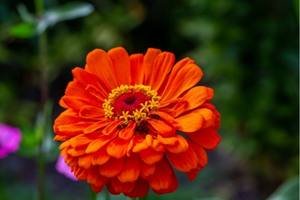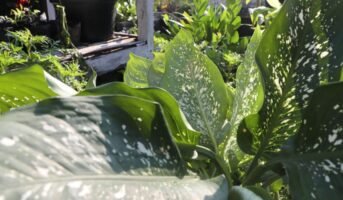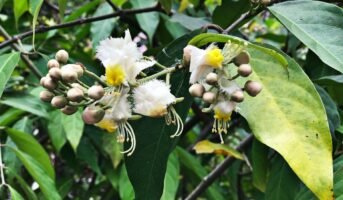To grow plants successfully in the summer, they must possess three essential traits: low maintenance, heat and drought endurance, and bright color. Zinnia Elegans fulfilled all three requirements. As a result, they are among the best flowers for use in gardens by skillful gardeners.
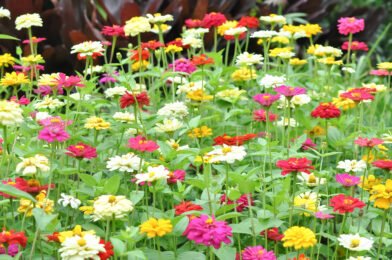
What is a Zinnia flower?
The Zinnia flower is a classical cottage flower and belongs to the Asteraceae family. Zinnia is known as the daisy family. The leaves of Zinnias are arranged opposite one another and frequently clasp the stem. They also have stiff, hairy stems. The species Zinnia elegans gave rise to the countless garden hybrids grown for their colorful flowers. At the intersection of branchlets and the receptacle, single flower heads are produced at the tips of branches. They are effortless to grow anywhere, and they increase. There are many various types of zinnias, but Zinnia elegans is the most popular.
Youth-and-old-age is another name for the Zinnia flower. They are indigenous to scrub and arid grassland in a region that extends from the Southwest of the United States to South America, with Mexico serving as a center of diversity. Gaillardia pulchella belongs to the Asteraceae family as well. Learn more about it.
Zinnia flower: Key facts
| Scientific name | Zinnia elegans |
| Taxonomic tree | Kingdom: Plantae
Clade: Asterids Order: Asterales Family: Asteraceae Genus: Zinnia Species: Z. elegans |
| Sun exposure | Full |
| Soil pH | Neutral to Slightly Alkaline |
| Bloom time | Summer
Fall |
| Flower color | Multicolor
Orange Pink Purple Red White Yellow |
| Toxicity | Non-toxic to humans, pets, and livestock |
| Special features | Attracts butterflies |
Types of Zinnia flowers
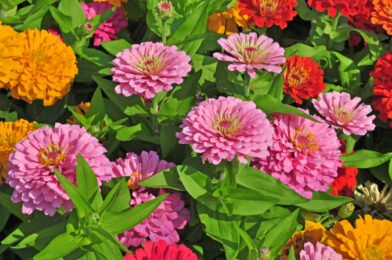
Based on petals
Single-flowered zinnia
This flower has one row of petals and is open at the center.
Double-flowered zinnia
There are several rows of petals on this flower, but their centers are concealed.
Semi Double-flowered zinnia
With several rows of petals yet clear centers, these flowers are somewhere in between.
Based on height
Thumbelina
With semi-double and double 2-inch blossoms in deep pink, lavender, salmon, pumpkin, red, yellow, and purple, multibranched flowers that are 12 to 18 inches tall are available.
Zahara
This variety of zinnia has enormous, mildew-resistant blooms.
State fair
Large dahlia-type blooms on tall stems are 3 to 5 inches wide and have double and semi-double flowers in salmon, yellow, red, white, lavender, and purple.
Dreamland
The tiny dwarf plant has two flower heads.
Envy
This type of Zinnia flower, 30 inches tall, has semi-double chartreuse blooms.
Is Zinnia Elegans a perennial?
The answer to this commonly asked question is ‘No’. Zinnia Elegans are annuals, which means that they go from seed to flower and back to seed quickly. These flowers bloom between the months of April and November.
How big are Zinnia Elegans?
Zinnia Elegans are leafy, bushy plants that grow up to 1-3 feet tall on upright, branching, and hairy stems. Sometimes, they can even reach a height of up to 4 feet.
Important factors for planting Zinnia
Temperature
Zinnias can tolerate daily temperatures as low as 60°F (16°C), although a range of 74–84°F (23–28°C) is ideal.
Space
Depending on the variety, leave 4 to 24 inches between plants. For information on each array, consult the back of the seed packet.
Plant zinnia seeds no more profound than ¼ inch.
Where is the best place to plant Zinnias?
When planning to plant Zinnias, it’s essential to choose a suitable location. To do this, make sure that the chosen location gets full sun to ensure that the flowers bloom all through the season. Also, it’s essential to make sure that the air circulation is good to prevent foliar diseases.
Zinnia flowers: Care Tips
Soil
Fungal illnesses like powdery mildew may develop on the blooms due to excessive wetness. Therefore, you must use well-draining soil. Although Zinnia flowers don’t have a preference for soil, they need a lot of space. Leave at least 6 inches between plants if you’re sowing zinnia seeds of a smaller type. Larger varieties of zinnias require a minimum distance of 12 to 18 inches between plants to ensure appropriate air circulation and disease control. Even with poor soil, zinnias will grow; you can improve it by adding compost to the plants.
Sunlight
The best place to cultivate the Zinnia flower is one that receives direct sunlight.
Sunlight will produce the most blossoms, keep the leaves dry, and prevent powdery mildew from developing on the leaves.
Water
Use water at the plant base only when required.
Watering Zinnias in the early morning gives the leaves and blooms plenty of time to dry out before dusk.
Zinnia flowers: Pest and diseases
Infestation is caused by mealybugs, caterpillars, and spider mites. Use a killing spray for an infestation if it is highly recommended. Zinnias may be harmed by powdery mildew, bacterial wilt, and fungal spots. To reduce the risk of infection, keep leaves from getting too damp and appropriately space your plants.
Cut the injured plant portions back to allow them to heal. Then, apply a fungicide containing potassium bicarbonate, neem oil, copper, or Sulfur.
Zinnia flowers: Propagation
Zinnia flower can be propagated in a few different ways-
- Splitting
- Using mature plants
- Cuttings
Potting Zinnia flowers
All zinnia seeds can be started in tiny pots, but only the shorter Zinnia cultivars can stay in pots.
If you must confine yourself to a container garden, think about utilizing hybrid bedding zinnias, which have a propensity for short, spreading growth habits.
Planting beds work best for tall cutting-type zinnias.
How to grow Zinnia Elegans from seeds?
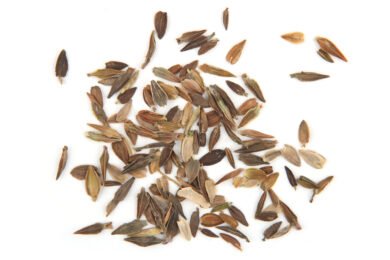
Seed collection
Zinnia seeds are simple to store. To release the seeds for the following year’s seed crop, allow the blossoms to dry thoroughly on the stalk before gathering the seedheads and lightly crushing them in your palm. Then, store it in a cool place.
Seed plantation
From the seed planted straight into the soil, zinnias proliferate. This blooming only needs consistently wet, well-drained soil to survive. Before planting seeds, work organic materials into planting areas if your soil is primarily clay.
Slow-release fertilizer should also be added to planting beds.
Before planting zinnia seeds, wait until all risk of frost has passed.
Afternoon light shade is ideal for zinnia plants.
Zinnia Elegans: Uses
- The tiny, narrow-leafed zinnia flowers yield gorgeous dried zinnia blooms and are excellent for hanging baskets.
- Insecticidal, antifungal, antioxidant, antibacterial, antimalarial, antiviral, cytotoxic (shown on cancer cell lines), and hepatoprotective. Also, the antimalarial activities of zinnia species have all been studied for their potential medical effects.
- You can eat the entire zinnia plant. You should only use the petals during cooking and discard the seeds.
Zinnia flowers: Toxicity
Zinnias are not at all poisonous or toxic to either humans or animals. In fact, these are actually edible flowers. So, it’s absolutely safe to plant them in your home garden.
FAQs
Are zinnias used as medicine?
A native plant called Zinnia Peruvian (L.) is used in popular treatment to cure stomach aches, malaria, and other ailments.
Why do farmers plant zinnias?
Zinnias with lots of nectar are excellent pollinators and will draw bees throughout their growing season, which is very helpful for farmers.
How long do zinnia flowers remain in bloom?
Zinnia flowers remain in bloom for 7-12 days
Where would zinnias survive the most?
The ideal zinnia growth and flowering conditions include full sun, well-drained grounds, and high levels of organic matter.
Housing News Desk is the news desk of leading online real estate portal, Housing.com. Housing News Desk focuses on a variety of topics such as real estate laws, taxes, current news, property trends, home loans, rentals, décor, green homes, home improvement, etc. The main objective of the news desk, is to cover the real estate sector from the perspective of providing information that is useful to the end-user.
Facebook: https://www.facebook.com/housing.com/
Twitter: https://twitter.com/Housing
Email: [email protected]
